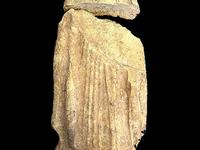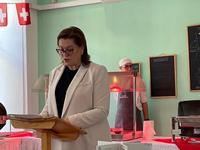Press Releases
15-02-2024 14:02
Excavation by the “Kalavasos – Laroumena and Arkhangelos Archaeological Research Project” (K-LAARP) in Kalavasos
The Department of Antiquities, of the Deputy Ministry of Culture, announces the completion of the excavation conducted by the “Kalavasos-Laroumena and Arkhangelos Archaeological Research Project” (K-LAARP) in Kalavasos during the 2023 season, under the direction of Dr Mara Horowitz. Christine Johnston served as assistant director and Enrico de Benedictis as field director.
The K-LAARP project studies the Middle Cypriot Bronze Age (c. 2000-1650 BC) in the Vasilikos Valley. Laroumena is a 15-hectare clifftop promontory adjacent to Arkhangelos, a 35-hectare terrace site with many surface finds indicating a large settlement. In the summer of 2023, two trenches, measuring 4x4 meters, were excavated on a small terrace on Laroumena. Multiple large drystone walls were already visible there in a section cleaned during the “Vasilikos Valley Project” survey in 1993, under the direction of Dr Ian Todd. Both squares yielded deposits securely dated, by pottery, to the later Middle Cypriot, while other pottery in the soil dated to the late Chalcolithic, the Early and Late Bronze as well as the Iron Age.
Excavations in Square 4N-4b revealed three walls forming a small room filled with thick ash and charcoal deposits. The back wall of this room is positioned beneath the modern terrace wall, supporting the theory that the Laroumena hillside was originally terraced in the Middle Cypriot period for architectural structures and not for agriculture. Square 4M-25d passed through a deep slope deposit of gravel rich in Middle Cypriot artifacts, indicating more Middle Cypriot activity on the adjacent uphill terrace. Below the stone layer was a single large wall of unusual thickness (0.9 meters) and associated floors. The relationship between the architecture in the two squares is not yet known.
Small finds included spindle whorls, shell beads, and a stone pendant. Pottery was of domestic character, probably related to food production. Stone tool-making was being carried out in the immediate vicinity, judged by the very large amount of worked stone flakes and blades in both local and exotic chert. Abundant finds of exceptionally large Red Polished Ware storage jar fragments indicate significant storage capacity.
The research will be carried on in order to determine the function of these structures on Laroumena and to investigate the possibility of public architecture and boundary walls of the type that mark the late Middle Cypriot period at other sites. Furthermore, the relation between Laroumena and the adjacent Arkhangelos settlement will be investigated in order to obtain information for its social and economic organization. The research suggests that there was prestige competition and communal surplus storage among local families during the Middle Cypriot period, a precursor to the development of a state society in Cyprus.
Figures:

Figure 1: Partly excavated room filled with ash and charcoal deposit. Rear wall runs under the current terrace wall. Square 4N-4b, Laroumena.

Figure 2: Large wall running downhill beneath a dense stone layer. Contemporary floors to the right and left of the wall. Square 4M-25d, Laroumena.
(NZ/IA)
Relevant Press Releases

22-11-2024 11:25
The “Royal Chapel” of Agia Aikaterini at Pyrga closed for the public



04-11-2024 13:18
Announcement by the Cyprus Academy of Sciences, Letters, and Arts





